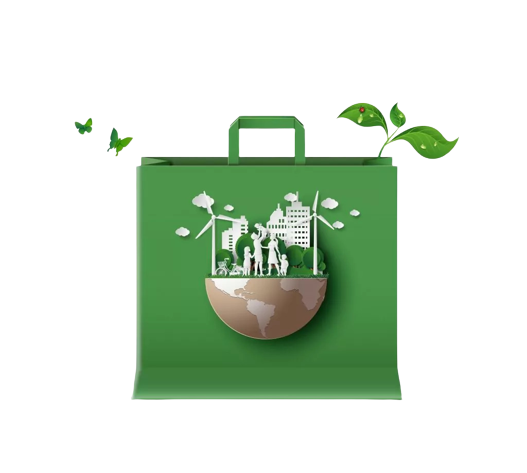Introduction
Although both of them serve the primary function of ‘wrapping’ and protecting items, there are differences regarding their manufacturing, what they are being used for, the alternatives available, and what is most suitable for you. ‘Cling wrap‘ reminds us of a kitchen image, but bubble wrap is that fun packing material which is covered with air ‘pop’ bubbles, and is very much used in packing. ‘Popping’ the bubble wrap is fun, and most people love to do it. Besides people searching for harmless packing materials, the world needs to use the ‘eco-friendly alternatives’ such as biodegradable stretch film, biodegradable bubble wrap, and compostable carry bags to minimize plastic waste. In this blog, we will learn about the main difference between cling and bubble wrap.
What is Cling Wrap?
Cling wrap and Saran wrap are names for the thin, flexible plastic films found mostly in kitchens. It’s mainly used for sealing food items, protecting the food from moisture loss, and preventing spoilage. Cling wrap is made to stick to surfaces and to itself due to static charge, flexibility, and thinness, so it can wrap items. Use of cling wrap is general in cases, for example, sandwiches and fruits, head bowls or plates, wrap leftovers and seal food items for the fridge, and pack lunch. Cling wrap helps maintain food freshness, preventing air from entering, thus minimizing the development of bacteria.
Cling wrap is made from light and flexible stretchable PVC or LDPE. These plastic materials, although lightweight and stretchable, are not eco-friendly; they are single-use and add to plastic pollution. These costs are the very reason behind the eco-friendly and compostable products, like compostable garbage bags are great alternatives to plastic bags.
What is Bubble Wrap?
Usually, Bubble Wrap consists of soft transparent sheets of plastic with little air-filled cushions and is designed to prevent packing or shipping breakage. Bubble Wrap is used mostly to protect and cover: shipping fragile glass, packing and shipping ceramics, electronics, artwork, and protecting furniture edges during travel. The small air cushions are designed to absorb shocks and reduce the chances of fractures, scratches, and breaks. Bubble Wrap also uses air, and this sealed air is used to maintain the lightweight and protective characteristics. Bubble Wrap is made of Polythene plastic, and Blister packaging contributes to making wrap, and also it is similar to cling wrap and is non-biodegradable.
Feature | Cling Wrap | Bubble Wrap |
| Main Use | Covers food & containers | Protects items from damage |
| Thickness | Very thin | Thicker with air pockets |
| Flexibility | Very stretchable | Flexible but not stretchable |
| Best for | Food preservation | Packing & shipping |
| Environmental Impact | Hard to recycle | Also hard to recycle but available in biodegradable options |
| Feel/Texture | Smooth & clear | Soft and bumpy with bubbles |
Which One is Better: Cling or Bubble Wrap?
Wrap results with single-use plastic waste. Both cling wrap and bubble wrap have their applications; however, when it comes to protecting fragile items, bubble wrap is far superior. Bubble wrap provides great cushioning and resistance to impact, so the items remain safe during shipment. On the other hand, cling wrap is very good for keeping things together or avoiding scratches. Here are some alternatives that are better for the environment: compostable carry bags for shopping and storage, compostable grocery bags for household packing, compostable garbage bags to reduce landfill waste, new compostable sambar pouches for safe liquid and food storage, compostable garment bags to package clothes, and biodegradable disposable glasses meant for events and parties.
Conclusion
All our compostable and biodegradable products help reduce pollution to protect the health of our seas and soil. The main point is that cling wrap and bubble wrap are both wraps; they are used for entirely different purposes: one protects food, and the other protects items during shipping. Each has ecological impacts, but at least they are biodegradable. Packaging waste can provide environmental benefits when compostable materials are used.
FAQ
1. Is cling wrap the same as bubble wrap?
No. Cling wrap is thin and sticky, used to cover food. Bubble wrap has air bubbles and is used for packaging and protection.
2. Can cling wrap protect fragile items?
Not really. It can hold items together but offers no cushioning. Bubble wrap is better for fragile items.
3. Is bubble wrap reusable?
Yes! You can reuse bubble wrap many times as long as the bubbles are not popped or damaged.
4. Which is better for shipping delicate items?
Bubble wrap is the best choice because it absorbs shock and prevents breakage.
5. Can cling wrap be used for food?
Yes, cling wrap is mainly designed for covering and storing food safely.
6. Can bubble wrap be used to wrap furniture?
Yes! Bubble wrap can protect corners and surfaces from scratches during moving.



